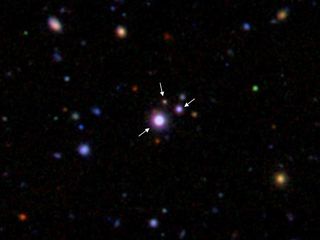
SEATTLE - Thediscovery of three distant supermassive black holes in proximity to one another is giving astronomers a glimpse into the chaotic early years of theuniverse.
Known as quasars,these incredibly bright objects are thought to be powered by gasfalling into enormous blackholes situated in the centers of galaxies.Although smaller than our solarsystem, a single quasar can outshine an entire galaxy of a hundred billion stars.
Roughly100,000 quasars have been observed in recent years, some of them doublequasars. But this is the first time that three quasars have been found sonear one another. The three quasars are separated by about 100,000 to 150,000light years--about the width of our MilkyWay [image].
"Quasarsare extremely rare objects. To find two of them so close together is veryunlikely if they were randomly distributed in space," said study leaderGeorge Djorgovski, an astronomer at Caltech. "To find three is unprecedented."
Thediscovery, made using the European Space Observatory's Very Large Telescope andthe W.M. Keck Observatory Hawaii, was reported here today at the 209thmeeting of the American Astronomical Society. A science paper on the researchhas been submitted to Astrophysical Journal Letters.
One of thequasars in the triplet, called LBQS 1429-008, was discovered in 1989 by a teamof astronomers led by Paul Hewett of the Institute of Astronomy in Cambridge,England.
Hewett'steam later spotted what appeared to be a faint companion to their quasar, butthey dismissed it as a visual illusion created by gravitationallensing, whereby light traveling towards Earth from distant galaxies is bent bythe gravity of massive objects--such as starclusters, darkmatter clumps or other galaxies--in their path. Sometimes, this can createmirror images of a galaxy in one or more different places in the sky.
Get the Space.com Newsletter
Breaking space news, the latest updates on rocket launches, skywatching events and more!
But the newobservations have revealed a third, even fainter companion to Hewett's quasarduo and, equally important, the lack of any galaxy that could possibly serve asa lens. This makes it highly unlikely that gravitational lensing isresponsible, the researchers say.
"Wejust could not reproduce the data," said study team member FredericCourbin of Ecole Polytechnique Federale de Lausanne in Switzerland. "It isessentially impossible to account for what we see using reasonablegravitational lensing models."
The teamalso observed small differences in the properties of the three quasars that arebest explained if the quasars are physically distinct objects.
Doublequasars are thought to form when two galaxies, each containing their own supermassiveblack holes, merge together. While the amalgamation of two black holes isthought to just create a larger black hole, the merger of three black holes isexpected to be more violent and interesting.
"Threeis so much better than two because the dynamics of three gravitationallyinteracting bodies is chaotic, as opposed to the much more regular motion oftwo bodies simply orbiting each other," said Frederic Rasio ofNorthwestern University in Illinois.
Rasio wasnot involved in the triple quasar observations, but his team has done recenttheoretical work showing that interactions between three supermassive blackholes might occur as frequently as a few times per year within the observableuniverse.
Rasio'swork also predicts that triple quasar encounters could eject one or more of thebright objects straight out of the host galaxy. These "naked" quasarsare then destined to wander alone through the universe.
The triplequasar discovery provides astronomers with a rare glimpse into an early, andmuch more chaotic, period of the universe. The quasar trio is located about10.5 billion light years away in the Virgo constellation [image].This means light from those quasars that astronomers now see were emitted whenthe universe was just over 3billion years old. During that early epoch, the universe was a much smallerspace; galaxies were also smaller and collided much more frequently.
"Quasarsare believed to be powered by gas falling into supermassive black holes,"Djorgovski said. "This process happens very effectively when galaxiescollide or merge, and we are observing this system at the time in the cosmichistory when such galaxy interactions were at a peak."
Editor'sNote: Allweek, SPACE.com is providing completecoverage of the 209th meeting of the American Astronomical Society.
- VIDEO: The Slow Birth of a Black Hole
- VIDEO: How Black Holes Beat the Clock
- All About Black Holes
Join our Space Forums to keep talking space on the latest missions, night sky and more! And if you have a news tip, correction or comment, let us know at: community@space.com.
Ker Than is a science writer and children's book author who joined Space.com as a Staff Writer from 2005 to 2007. Ker covered astronomy and human spaceflight while at Space.com, including space shuttle launches, and has authored three science books for kids about earthquakes, stars and black holes. Ker's work has also appeared in National Geographic, Nature News, New Scientist and Sky & Telescope, among others. He earned a bachelor's degree in biology from UC Irvine and a master's degree in science journalism from New York University. Ker is currently the Director of Science Communications at Stanford University.
